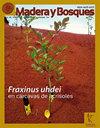以人工林木渣为原料制备中密度纤维板的性能研究
IF 0.6
4区 农林科学
Q4 FORESTRY
引用次数: 0
摘要
Bolaina (Guazuma criita Mart.)是秘鲁乌卡亚利森林人工林中应用最广泛的植物物种之一。bolaina木材的产量增加了,因此木材残留物的产生也增加了。幸运的是,这些废物可以用作制造其他产品的原料。本研究旨在生产至少可以达到欧美中密度纤维板(MDF)最低要求的测试板,该测试板使用两种纸浆,即精炼机械纸浆(RMP)和化学机械纸浆(CMP),这些纸浆来自5至8年森林种植园的博莱纳木渣,并使用两种树脂:脲醛(UF)和乳液聚合物异氰酸酯(EPI)。为制备RMP和CMP,分别对木渣进行水和5%氢氧化钠(w/w)浸泡预处理24 h,并使用Morfi紧凑设备对两种纸浆的纤维形态参数进行分析。此外,还对木材和纸浆进行了化学表征。经蒸馏水稀释的脲醛树脂固含量为65%,EPI为23%。两种树脂均以10% (w/w)的剂量施用。制备了四种MDF: RMP-UF、CMP-UF、RMP-EPI和CMP-EPI。研究结果证实了以木渣(5%树皮)为原料制备中密度纤维板的可行性。在树脂的贡献方面,添加EPI的中密度纤维板比添加UF的中密度纤维板具有更好的物理和机械性能。RMP和CMP纸浆在MDF中具有相似的性能。RMP-EPI和CMP-EPI板表现出最好的性能。本文章由计算机程序翻译,如有差异,请以英文原文为准。
Characterization of MDF produced with bolaina (Guazuma crinita Mart.) wood residues from plantation
Bolaina (Guazuma crinita Mart.) is one of the most widely used plant species in the forest plantations in Ucayali, Peru. The production of bolaina wood has increased, consequently the generation of wood residues has also risen. Fortunately, this waste can be used as raw material to manufacture other products. This study aims to produce test boards that can achieve at least, the minimal requirements of European and American standard for medium-density fiberboards (MDF) produced using two types of pulps, namely refiner mechanical pulp (RMP) and chemi-mechanical pulp (CMP), from bolaina wood residue obtained from a 5 to 8-year-old forest plantation and using two types of resins: urea-formaldehyde (UF) and emulsion polymer isocyanate (EPI). To manufacture RMP and CMP, wood residues were pretreated through water and 5% sodium hydroxide (w/w) soaking respectively for 24 h. The fiber morphological parameters of both pulps were analyzed using the Morfi compact equipment. Additionally, woods and pulps were also chemically characterized. The solid contents of the resins were 65% for UF and 23% for EPI diluted with distilled water. Both resins were applied with a dose of 10% (w/w). Four types of MDF were prepared: RMP-UF, CMP-UF, RMP-EPI, and CMP-EPI. The results confirmed the feasibility of preparing MDF with wood residues (5% bark) of bolaina as the raw material. In terms of the contributions of resins, MDF with EPI exhibited better physical and mechanical properties than that manufactured with the UF. The pulps, RMP and CMP, had similar performance in MDF. The RMP-EPI and CMP-EPI boards exhibited the best properties.
求助全文
通过发布文献求助,成功后即可免费获取论文全文。
去求助
来源期刊

Madera Y Bosques
FORESTRY-
CiteScore
0.90
自引率
0.00%
发文量
16
审稿时长
>12 weeks
期刊介绍:
Madera y Bosques (Wood and Forests) is a scientific periodical journal which has the objective of serving as media for scientific and technological research related to forest products, forest management and conservation as well as forest ecology topics and related subjects. It publishes original scientific papers, topical articles, scientific notes or bibliographic reviews. It is a quarterly publication that appears in Spring, Summer and Fall. Ocassionally, special Winter Issues are published. Manuscripts are accepted in Spanish, English and sporadically in other languages. It has no Page Processing Charges and it is published by the Environment and Sustainability Department of the Instituto de Ecología, A.C. (Xalapa, Ver., México).
 求助内容:
求助内容: 应助结果提醒方式:
应助结果提醒方式:


